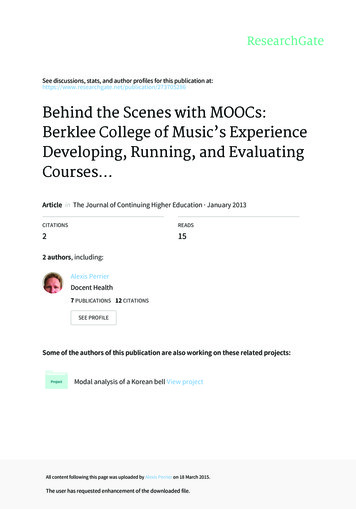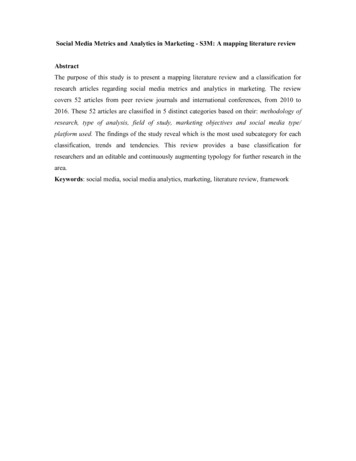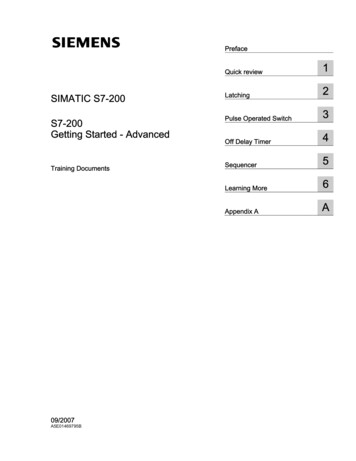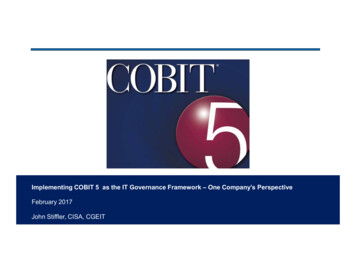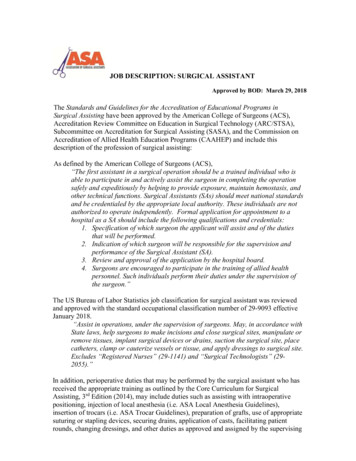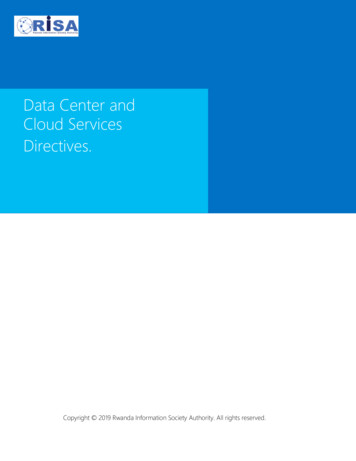
Transcription
Data Center andCloud ServicesDirectives.Copyright 2019 Rwanda Information Society Authority. All rights reserved.
Table of Contents1.INTRODUCTION . 61.1.SCOPE . 61.2. REFERENCES . 61.3. ACRONYM . 62.DATA CENTER DESIGN PROCESS . 72.1. Data center Tier . 73.SELECTION AND EVALUVATION OF THE SITE . 83.1. Site Access . 93.2. Site Security . 103.3. Water and Sanitary sewer. 103.4. Utility Services. 113.5. Natural Gas and Other fuels . 113.6. Regulations. 124.SPACE PLANNING . 134.1. Power Systems . 144.1.1. Electric Utility Service Feeds . 154.1.2. Generator Power. 154.1.3. Cooling Capacity . 164.2. Security . 164.3. Telecommunications Entrance Room . 164.4. Service Provider Considerations . 174.5. Command Center . 174.6. Helpdesk. 184.7. Print . 184.8. Loading Dock . 184.9. Storage . 184.10. Staging. 194.11. Administrative and engineering office. 194.12. Waste/Recycle . 195.ARCHITECTURAL AND STRUCTURAL DESIGN . 205.1. Site Selection . 201
5.2. 24/7 Operation of Data Center- Temperature and Relative Humidity Control . 215.3. Materials . 225.4. General Paths of Access . 225.5. Planning Detail . 235.6. Computer Room . 245.7. Entrance Rooms . 245.8. Mechanical Room . 245.9. Electrical Room and UPS Room. 255.10. Fire Suppression Room . 255.11. Circulation . 255.12. Equipment Staging and Storage . 265.13. Floor Slab . 265.14. Computer Room Wall Construction . 275.15. Fire-Rated Construction . 285.16. Access Control Systems. 295.17. Airborne Particles. 295.18. Access Flooring System . 295. 19. Ceilings . 315.20. Equipment Bracing System . 315.21. Structural Building Code Compliance and Coordination . 325.22.6.Structural Concerns Specific to Data Center Design . 325.22.1.Raised Access Floors . 335.22.2.Wind . 335.22.3.Earthquake . 335.22.4.Blast and Terrorist Attack . 34POWER AND ELECTRICAL SYSTEMS DESIGN . 346.1. Transformers: . 356.2. On Site Generation. 366.3. Availability . 376.3.1. 2N Redundancy . 376.3.2. 2(N 1) Redundancy. 376.3.3. Multi-N Redundancy (xN). 376.4. Electrical Class Ratings . 386.4.1. Class F3 . 386.4.2. Class F4 . 392
6.5. UPS SYSTEM . 416.6. Synchronization. 456.7. UPS Output Switchboards . 456.8. Ties and Interconnections . 456.9. UPS Output Distribution . 466.10. Power Distribution Units (PDUs). 466.11. Direct Current (DC) Power Systems . 476.12. Computer Room Equipment Power Distribution. 496.13. Load Management . 506.14. Automation and Control, Monitoring . 516.15. Bonding, Grounding, Lightning Protection, and Surge Suppression . 527.15.1. Lightning Protection . 566.16. Building Ground (Electrode) Ring. 586.16.1. Personal Grounding and Static Discharge . 606.17. Labeling and Signage. 617.MECHANICAL AND COOLING SYSTEM . 627.1. Air conditioners and air handlers. 637.2. Hot aisle/cold aisle . 637.3. Hot aisle/cold aisle containment . 648.FIRE PROTECTION. 678.1. Fire detection . 688.2. Fire suppression . 70Recommended Sprinkler Systems for Data Center Spaces. 719.DATA CENTER CABLING SYSTEMS . 719.1. Data center network cabling design . 7310.1.1. Entrance Rooms . 7410.1.2. Main Distribution Area (MDA) . 759.1.3. Intermediate Distribution Area (IDA). 769.1.4. Horizontal Distribution Area (HDA). 769.1.5. Zone Distribution Area (ZDA) . 779.1.6. Equipment Distribution Area (EDA) . 779.2. Outside Plant Cabling Infrastructure . 779.3. Aerial Service Pathways . 789.4. Service Providers . 789.5. Application cabling lengths . 803
9.5.1. T-1, E-1, T-3 and E-3 circuit lengths . 809.6. Telecommunications Cabling Infrastructure Classes . 819.6.1. Class C0 and C1 Telecommunications Infrastructure . 819.6.2. Class C2 Telecommunications Infrastructure . 829.6.3. Class C3 Telecommunications Infrastructure . 839.6.4. Class C4 Telecommunications Infrastructure . 849.7. Cabling Topology . 869.7.1. Horizontal cabling . 869.7.2. Backbone cabling . 869.7.3. Equipment cabling . 8710.DATA CENTER CABLING PATHWAYS . 8710.1. Cable Tray Support Systems. 8810.2. Overhead Cable Trays . 8810.3. Underfloor Cable Trays . 8810.4. Backbone Cabling . 9010.5. Cabling Types . 9110.5.1. Centralized Optical Fiber Cabling . 9210.5.2. Horizontal Cabling . 9210.5.3. Balanced Twisted-Pair Cabling . 9310.6. Cabling Installation. 9310.7. Telecommunications and Computer Cabinets and Racks. 9410.8. Cabinet Airflow and Cabling Capacity . 9610.9. Cabinet and Rack Installation. 9710.10. Thermal Management in Cabinets. 10011.DATA CENTER HIGH AVAILABILITY . 10111.1. Data center infrastructure Tiers. 10311.2. N - Base requirement . 10411.3. Concurrent maintainability and testing capability. 10411.4. Capacity and scalability . 10411.5. Isolation. 10411.6. Data center tiering . 10411.6.1. Tier I Data Center: Basic . 10411.6.2. Tier II Data Center: Redundant Components. 10511.6.3. Tier III Data Center: Concurrently Maintainable. 10511.6.4. Tier IV Data Center: Fault Tolerant . 1054
11.6.5. Tier 3 . 10511.6.6. Tier 4 . 10811.7. Secure Operation: . 10911.7.1. Security of Datacenter: . 11012.CLOUD SERVICES DIRECTIVES . 11212.1. Introduction . 11212.2. Cloud Deployment Model . 11212.2.1. Public cloud . 11212.2.2. Private cloud . 11212.2.3. Community cloud . 11312.2.4. Hybrid cloud . 11312.3. Cloud Service Model . 11312.3.1. Infrastructure as a Service . 11312.3.2. Platform as a Service (Paas) . 11412.3.3. Software as a Service . 11412.4. Facilities . 11412.5. Organization-Human resources . 11412.6. Cloud Infrastructure . 11512.7. Asset management and monitoring . 11512.8. Cloud Security . 11512.9. Physical Security. 11612.10. Network and Infrastructure Security . 11712.11. Applications and Database Security. 11812.12. Security and Compliance. 11812.13. Information Security . 11912.14. Security Operations and Management . 12012.14.1. Incident response. 12012.14.2. Forensics Investigation . 12012.15. Business continuity and Disaster Recovery . 12112.16. Control Mapping . 1215
1. INTRODUCTIONData Center is a centralized dedicated place that provides the information-processing infrastructurespecifically the IT and Telecommunications equipment such as servers, storage equipment and the corenetwork infrastructure.Considering the above critical functions of this equipment as it requires operating 24x7 with operationalrequirements such as cooling, ambient temperature; exceptional attention needs to be taken to ensurethat the optimum environment exists for it operations.Several factors need to be considered in setting up the Data Centre. This guideline provides the factorsthat need to be considered in setting up and managing a data center.1.1.SCOPEThese guidelines provide best practices and implementation methods that complement TIA, CENELEC,ISO/IEC and other published data center standards and documents. It is primarily a design standard, withinstallation requirements and guidelines related to implementing a design. The standard includes otherinstallation Requirements and guidelines for data centers where appropriate.1.2. REFERENCESBelow standards and best practices have been referred to prepare this datacenter directive document ANSI-TIA 942 – Telecommunications Infrastructure standards for Datacenters BICSI - Data Center Design and Implementation Best Practices ASHRAE Thermal Guidelines or GR-3028-CORE1.3. ACRONYMEMIITECRACHVACSPDNFPAIBC- Electromagnetic Interference- Information Technology Equipment- computer room air conditioners- Heating, ventilation, and air conditioning- Surge Protection Device- Standard for Fire Protection of Information Technology Equipment- International Building Code6
2. DATA CENTER DESIGN PROCESSA Well thought DC design process is the mandatory consideration for any Data Center within Rwanda. AsData center is the nerve center of IT computing infrastructure. These requirements must be consideredwhile designing Data center.Datacenters need to meet the space requirements, ambient environment and necessary security controlsto protect the critical IT infrastructure that resides within.Following are some key considerations: Site location and space considerations Architectural and Structural loading considerations Electric Power and backup power considerations Fire protection and cooling considerations Redundancy / Business continuity considerations Green Data Center considerations Security Considerations Operational considerationsIt is essential that the design of the telecommunications cabling system, equipment floor plan, electricalplans, architectural plan, HVAC, security, and lighting systems must be aligned to each other. Ideally, thedesign process should be able to give: Estimate telecommunications, space, power and cooling requirements of the data centerat full capacity and scalability.Space, power, cooling, security, floor loading, grounding, electrical protection and otherfacility requirements should be designed by well-qualified architects and engineers.Plan adequate space for operations Center, loading dock, storage room, staging areas andsupport areas. Floor plan should include placement of entrance Rooms, main distributionareas, intermediate distribution areas, horizontal distribution areas, zone distributionareas and equipment distribution areas.Conduct a risk assessment and plan appropriate security controls. These controls shouldbe included in each aspect of Datacenter.2.1. Data center TierThe data center operating within Rwanda should be above Tier three. There are four types of a tier andare defined by uptime standard.Tier 1Tier 2Tier 3Tier 499.671% Availability99.741% Availability99.982% Availability99.995% AvailabilityNon-Redundant capacity components (Single uplink and servers)Tier 1 Redundant capacity componentsTier 1 Tier 2 Dual Powered equipment and multiple uplinksTier 1 Tier 2 Tier 3 All components are fully fault tolerant including uplinks, storage,chiller, HVAC Systems, Servers and everything is dual powered7
3. SELECTION AND EVALUVATION OF THE SITEThis section emphasizes the requirements for evaluating and selecting a suitable site for the Data center,whether the location is a new site that involves the construction of a new data center or reviewing thelocation of an existing building that will function as a data center, or the ranking of an already existing andoperational data centers when considering closure or consolidation. The location of the datacenter should be unobtrusive so as not to attract any unnecessaryattention and the site should not be located directly above water pipelines or anydrainage piping as it has the risk of water leakage.The location where possible earthquakes and low level vibrations (less than rector scale2) are likely to happen should be avoided and the Data center should not be located in ornear an area with an active volcanoes.The Datacenter should not be placed near an urban development or protected naturalareas where there are high chances to get wildfire. The history of location must be verifiedand certified by local district offices.The site location should be checked for the risk of a flood of a river or possible break of alake and the site should not be located near/in an area where there is high possibility ofintolerable levels of wind such as storms, tornadoes, hurricanes, cyclones and heavyrainfall.The quality and the stability of the soil should be tested and certified and any possibilityof land sliding should be verified by local district offices.The site should be checked for acceptable levels of noise including the noise levels thatwill be produced by equipment.The equipment like generators, cooling towers should have silencers and soundattenuated enclosures. Outdoor equipment should incorporate sound barriers within thearchitectural screening.The impact of lightning must be verified, and the recommended flash rate of 10 or less is
2. DATA CENTER DESIGN PROCESS A Well thought DC design process is the mandatory consideration for any Data Center within Rwanda. As Data center is the nerve center of IT computing infrastructure. These requirements must be considered while designing Data center.

